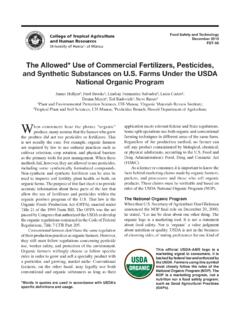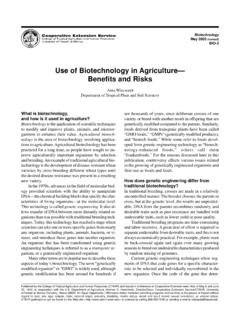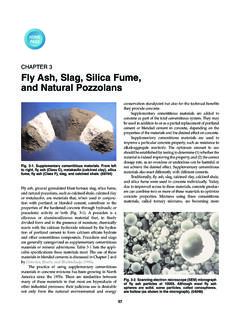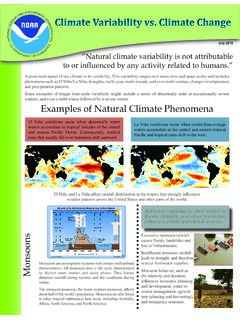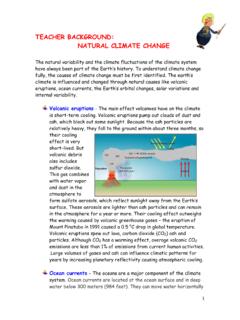Transcription of Natural Farming: Fermented Plant Juice - University of Hawaiʻi
1 Sustainable Agriculture August 2013. SA-7. Natural Farming: Fermented Plant Juice Sherri A. Miller1, David M. Ikeda1, Eric Weinert, , Kim Chang1, Joseph M. McGinn1, Cheyanne Keliihoomalu2, and Michael W. DuPonte2. 1. Cho Global Natural Farming Hawai i, Hilo, HI. 2. College of Tropical Agriculture and Human Resources, Cooperative Extension Service, Hilo, HI. Introduction ment. The balance is maintained Hawai i is heavily dependent on by encouraging the growth of imported food to feed its residents naturally occurring indigenous mi- and visitors; moreover, conven- croorganisms (IMO), which in turn tional agricultural production in produce nutrients that are used in the state also relies on imported the production of crops and live- inputs (feed, fertilizer, compost, stock.)
2 Virtually all of the inputs pesticides). In order for Hawai i to used in KNF, as compared to those move toward food self-sufficiency, used in conventional agricultural reliance on imported food and ag- practices, are available locally at ricultural inputs must be reduced a fraction of the cost of imported while increasing food production feeds, composts, and fertilizers. using locally available, economical Cultivation of IMO was covered inputs. Hawai i's farmers cannot Figure 1: Young, vigorously growing an- in a previous publication (Park and continue on their present course gelica herb is a good choice for making DuPonte 2008).
3 This bulletin cov- without serious repercussions FPJ in Hawai i. ers the preparation of another KNF. to their sustainability, both eco- input, Fermented Plant Juice (FPJ). nomically and environmentally. Alternate agricultural production systems adapted to the semi-tropics, includ- What Is Fermented Plant Juice ? ing organic and permaculture methods, have met with FPJ is used in solutions for seed and soil treatments and varying levels of success. Plant nutrition. It consists of the young shoots of vigor- Korean Natural Farming (KNF) is a sustainable ously growing plants that are allowed to ferment for system developed by Master Han Kyu Cho of the Janong approximately 7 days with the aid of brown sugar.
4 The Natural Farming Institute in South Korea, based on brown sugar draws the juices out of the Plant material generations of sustainable farming methods practiced via osmosis and also serves as a food source for the mi- in Japan, China, and Korea. KNF optimizes the produc- crobes carrying out the fermentation process. The weak tion of plants or livestock through farming methods that alcohol produced during fermentation extracts chloro- maintain a balance in nutrient input and output, thus phyll (soluble in ethanol) and other Plant components.
5 It minimizing any detrimental effects on the environ- is non-toxic and edible. Published by the College of Tropical Agriculture and Human Resources (CTAHR) and issued in furtherance of Cooperative Extension work, Acts of May 8 and June 30, 1914, in co- operation with the Department of Agriculture, under the Director/Dean, Cooperative Extension Service/CTAHR, University of Hawai i at M noa, Honolulu, Hawai i 96822. Copyright 2011, University of Hawai i. For reproduction and use permission, contact the CTAHR Office of Communication Services, 808-956-7036.
6 The University is an equal opportunity/affirmative action institution providing programs and services to the people of Hawai i without regard to race, sex, gender identity and expression, age, religion, color, national origin, ancestry, disability, marital status, arrest and court record, sexual orientation, or status as a covered veteran. Find CTAHR publications at UH CTAHR Natural Farming: Fermented Plant Juice SA-7 Aug. 2013. What Affects the Quantity and Quality of FPJ? limited to, purslane (Portulaca or pigweed), watercress, The most important requirement when selecting plants angelica (see Fig.)
7 1), bamboo shoots, sweetpotato vines, for making FPJ is to use the growing tips of Plant species beans, pumpkin, and seaweeds (Table 1). KNF practices that are fast growers. Flowers, flower buds, and immature emphasize using what is available. Do not use poisonous fruits can also be used. Hard or woody Plant parts will plants ; if in doubt, have plants identified through your yield little or no Plant Juice . The plants should be vigor- local extension service. ously growing at the time of collection. Plant parts should be harvested while the plants are in respiration mode When Is the Best Time to Make FPJ?
8 (before sunrise) and not in photosynthetic mode (during FPJ can be made year-round in Hawai i. In temperate daylight), due to the effects these processes have on Plant climates, FPJ is usually made during the warmer months chemistry. Avoid collecting Plant parts during or after when Plant growth is vigorous and growing tips are rainfall (ideally, wait two sunny days after rain stops) abundant. and do not rinse collected Plant parts, to conserve their surface microbial populations (lactic acid-producing Making Fermented Plant Juice (FPJ).)
9 Bacteria and yeasts), which will carry out the fermenta- Step 1. Collect Plant material tion process. Low levels of these microbes will result in Before sunrise, collect the fast-growing tips (2 3. improper fermentation and/or low yields of Plant Juice . inches long) of plants ; for plants with longer tendrils, such as sweetpotato, longer pieces can be collected. What Kinds of plants Can Be Used to Make FPJ? Avoid collecting during or after rainfall. plants should be vigorous, fast-growing, and healthy. In Korea, the most commonly used plants are mugwort Step 2.
10 Cut and weigh the Plant material (Artemisia vulgaris) and dropwort (Oenanthe javanica). Do not rinse collected Plant parts, so as to conserve Other ideal choices grown locally include, but are not surface microorganisms. Record the weight of the Table 1. plants commonly used to make Fermented Plant Juice (FPJ) in Hawai i Common Name Scientific Name Plant Part Angelica Angelica sp. Shoot tips Bamboo Various genera Shoot tips Beans Various genera Shoot tips Dropwort Oenanthe javanica Shoot tips Mugwort Artemisia vulgaris Shoot tips Noni Morida citrifolia Immature fruit Purslane Portulaca oleracea Shoot tips Seaweed Various genera Shoot tips Squash shoots Cucurbita spp.





